The 2013 MacBook Air: Core i5-4250U vs. Core i7-4650U
by Anand Lal Shimpi on July 4, 2013 8:00 AM ESTBoot Performance
Although boot performance doesn't change substantially with the faster CPU, I did notice that the new system was posting better boot times than what I had previously recorded. My guess is all of my SSD torturing hadn't been TRIMed away before I presented the previous results. Either way the new MBA seems capable of a sub-12 second boot time. I even recorded some boots as low as 10.8 seconds. That PCIe SSD comes in handy for sure.
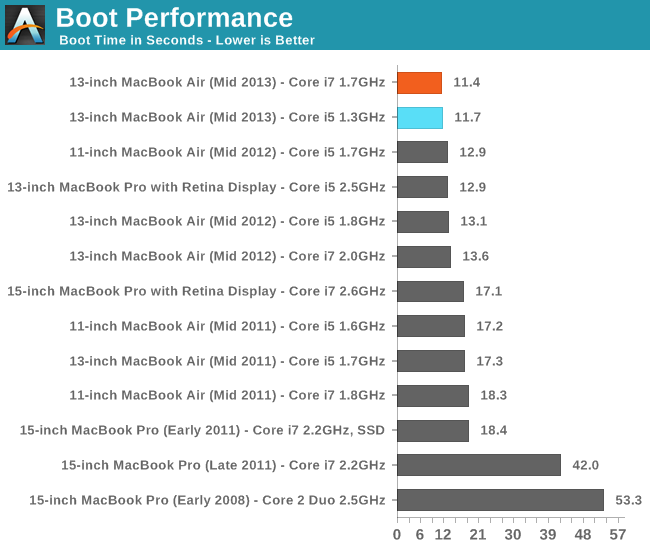
Single Threaded FP & 3D Rendering Performance
These next two charts look at single and multithreaded floating point performance using Cinebench 11.5. This test also gives us the rare opportunity of comparing to some older Mac Pro hardware as well from 2008 - 2010. Single threaded performance remains extremely important to overall system responsiveness, so it's always good to look at.
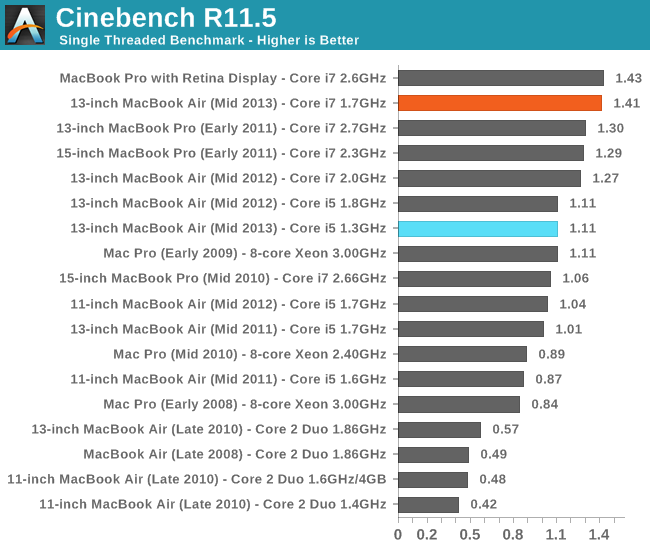
Oh man, the Core i7 upgraded seriously fixes everything. We get near perfect scaling here, showing a massive 27% increase in performance over the default Core i5 1.3GHz setup. The single threaded performance of the upgraded 13-inch MacBook Air is almost able to equal that of the 15-inch MacBook Pro with Retina Display. Anyone underwhelmed by Haswell should keep this in mind. What we're seeing here is a combination of IPC improvements and awesomely aggressive turbo, all within a 15W TDP.
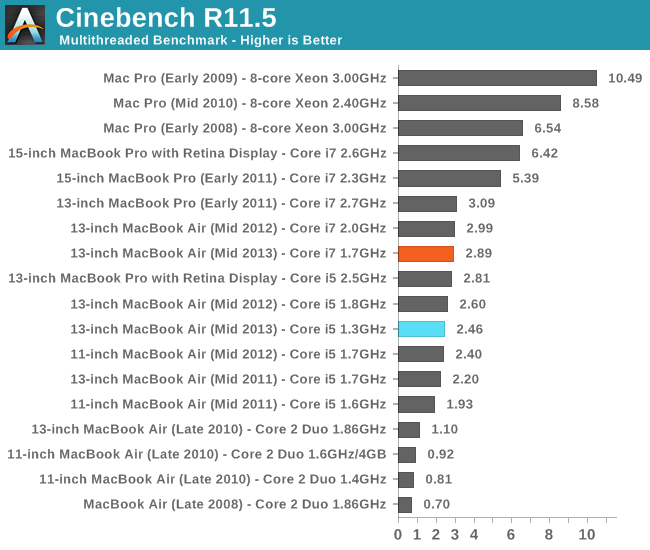
The multithreaded story is a bit less impressive, but still quite good. Showing a 17% increase in performance, the 1.7GHz Core i7 delivers nearly the same performance as the 2GHz Core i7 upgrade from last year's MBA. The rMBP15 distances itself from the MacBook Air though - there's no replacement for more cores.
Video Transcoding Performance
Video transcoding is really best suited for the higher end machines, but that doesn't change the fact that it's done on MacBook Airs as well. We'll start by looking at performance under iMovie. Here we're importing 1080p video from a Nikon D7000 and optimizing it during import.
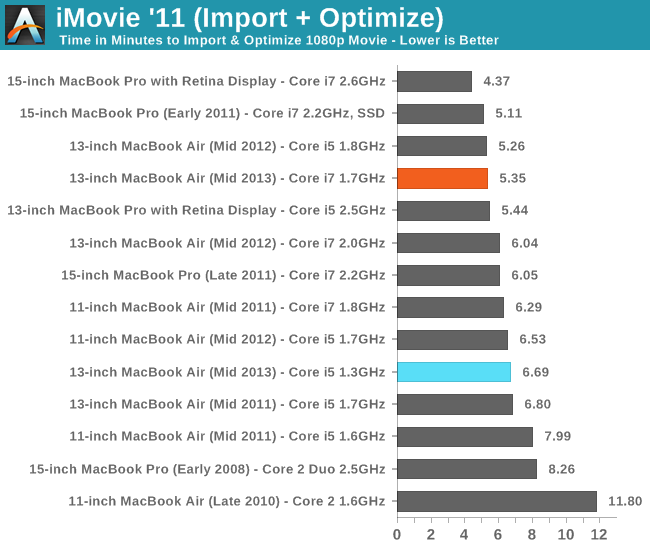
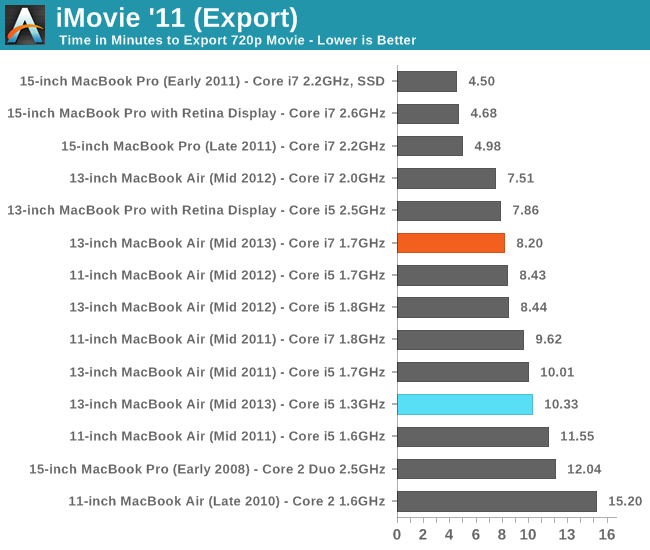
We're showing ~25% reductions in import and export time here over the base configuration. In both cases, performance equivalency with last year's upgraded configuration seems restored.
Final Cut Pro X falls on the professional end of the video production spectrum. The test file is the same here, but the workload is far more strenuous.

The same is true for our FCPX test. Last year's 2.0GHz model is about 5% quicker than this year's 1.7GHz Haswell ULT system, but obviously with the newer machine you get much better battery life. The improvement over the base CPU configuration is over 20% again.
Photo Editing & Export Performance
Our photo editing & export tests agree with what we've seen elsewhere. The gains here are north of 20% and put the i7 system within range of last year's 2GHz model.


Xcode Performance
In our desktop review of Haswell I noted that performance in our compile test improved tremendously with the new architecture. As it's quite obvious that Haswell's IPC advantages don't surface all that much in our traditional suite, I wanted to see if perhaps things would be different in something that might lend itself better to Haswell's IPC improvements. I repeated our Firefox build test but under OS X. It's a multithreaded compile, with the number of threads set to 2x the number of cores (not threads) in a system.
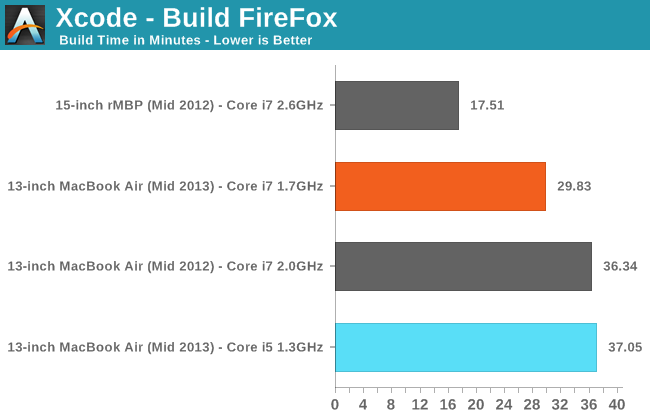
When Haswell's IPC advantage can shine, the higher clocked configuration does even more so. Here the 1.7GHz Core i7-4650U is over 20% faster than the fastest MacBook Air you could build last year. Serious developers will still want more cores but if you need ultimate portability, Haswell ULT really can shine.










127 Comments
View All Comments
josephandrews222 - Thursday, July 4, 2013 - link
Anand--wonderful post. Care to speculate on the battery life and thermals for the Surface Pro 2?teiglin - Thursday, July 4, 2013 - link
Derp in last paragraph, first page: "The max clocks increase by almost 30%, as does the <s>increase in</s> L3 cache."Nothing really surprising here, but good to see it confirmed anyway!
Subyman - Thursday, July 4, 2013 - link
I wouldn't call the lower battery life a detriment, remember you have 20% less battery time, but you have 20% more processing speed, therefore you simply get the same amount of work done, but faster. For general surfing, there is no difference between the two but when working its faster.TheinsanegamerN - Thursday, July 4, 2013 - link
am I the only one more than a little disturbed to see temperatures of over 90c? thats awfully hot....MrSpadge - Thursday, July 4, 2013 - link
That's the price you have to pay for a flat laptop, without totally killing your ears.Paapaa125 - Thursday, July 4, 2013 - link
It doesn't matter what the core temperature is if it is within specs. And I guess 90C is.FwFred - Thursday, July 4, 2013 - link
This should only matter if the CPU was throttling due to temperature. As a consumer, you should be more concerned with skin temperature and fan noise.solmaker - Thursday, July 4, 2013 - link
Fantastic job on a fascinating topic. Two follow-up questions:1) Would i7 compare any different to i5 on the 11" model, given tighter thermals?
2) How will the comparison change under Mavericks?
My own thinking is that if Mavericks improves battery life by (say) another 25% across the board, 2013 MBA battery life will be so terrific (perhaps 12 hours even for the 11" i7 MBA) that 1/2 to 1 hour differences between models will seem like small change. At that point, processing speed would be the more important bottleneck, making the i7 look like an even better choice.
helloworldv2 - Thursday, July 4, 2013 - link
My guess is that Maverics increases battery life by 5% max and will inject a ton of new annoyances into OS X (like having to caffeinate everything that you want to keep on running even if you dare to take some other program into foreground). I read somewhere (maybe Gizmodo) that they didn't notice any battery life increase with Mavericks beta though..KitsuneKnight - Thursday, July 4, 2013 - link
A 25% increase across the board I'd say is incredibly unlikely. What seems far more likely, though, is making more workloads closer to being a 'light' workloads (so hitting closer to the advertised numbers in more cases).Timer Coalescing and AppNap will make it less likely for noisy apps to drain significant battery life when merely sitting in the background doing nothing (including background tabs of Safari, I believe... which'll hopefully include Flash applets on background tabs). This will help improve the likelihood of the CPU being able to hit lower idle states, saving more power.
In addition, Apple has put effort into making it easier to identify power hungry apps (which aren't necessarily CPU hogs!), both for end users and developers (the battery menu, Activity Monitor, Xcode, and Instruments all have an increased focus on identifying and addressing battery hogs).
But don't expect miracles like a 25% increase in battery life (I'd be *very* shocked if Apple was able to pull that off). I'd imagine it would be much closer to 5% in practice, but varying drastically depending on the actual workloads (anywhere from 0% if the system can't sleep at all to 50%+ in the extreme case of a horribly buggy app that AppNap neuters... with most clustering around the low end).